It’s vital to take the correct safety measures whenever using a laser cutter, one being to have suitable safety glasses. If you don’t have appropriate glasses for the laser wavelength you’re using, you risk damaging your eyes.
To help you stay safe when laser cutting and engraving, we’ve reviewed the best laser safety glasses. I’ll cover various glasses that cover all types of lasers and every range of wavelengths, so you can skip to the section that applies to you.
Best Laser Protection Glasses for Diode Lasers
Diode lasers are the weakest type of laser, typically used in the most affordable hobbyist lasers.
While diode lasers can come in many different wavelengths, 445nm and 450nm are the standard.
FreeMascot IPL
- Price: Check latest price at Amazon here
- Wavelengths: 200-2000nm
- Optical density: OD 4+
- Visible light transmission: 15%
- Laser safety standards: CN EN207
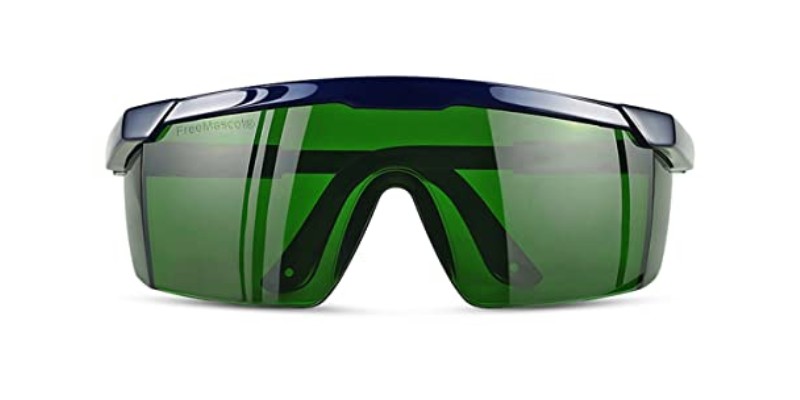
Pros
Great for beginners on a budget.
Can be used with many lasers.
Cons
Not good for doing lots of intensive laser work.
Not the easiest to see out of.
If you’re a beginner looking for a budget option, these cheap FreeMascot laser safety glasses are a popular choice, with a 4.5-star Amazon rating.
They have broad spectrum protection from wavelengths of 200nm-2000nm, so they can be used with many different lasers.
However, bear in mind that if you’re doing a lot of intensive laser work or are working with powerful lasers, it’s best to use glasses with a higher optical density of 5+ or 6+.
Also, the 15% visible light transmission means these glasses aren’t the easiest to see through, so they’re only recommended as a cheap option for light and sporadic laser work.
FreeMascot Professional OD 6+
- Price: Check latest price at Amazon here
- Wavelengths: 190nm-490nm
- Optical density: OD 6+
- Visible light transmission: 55%
- Laser safety standards: CN EN207
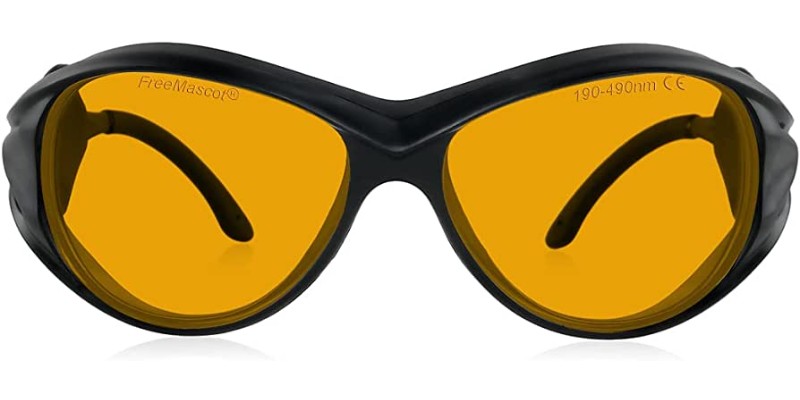
Pros
Great for many popular hobbyist machines.
Comes in a protective case, along with a cleaning cloth, to help your glass in a suitable condition.
Comfortable, with the ability to choose from a variety of frames and filters.
Cons
No major drawbacks.
FreeMascot OD 6+ glasses are a great pair of diode laser safety glasses that block the required wavelengths of many popular hobbyist machines.
FreeMascot is one of the leading laser safety brands, using leading material science in their polycarbonate lenses to ensure their products boast the most advanced absorbers and coatings.
Each pair comes in a protective case, along with a cleaning cloth, to help you keep your glasses in a suitable condition.
FreeMascot laser protection glasses also rank highly in terms of comfort, with the ability to choose from a variety of frames and filters.
Ortur Laser Safety Glasses
- Price: Check latest price at Amazon here
- Wavelengths: 180nm-750nm
- Optical density: OD 4+
- Visible light transmission: 70%
- Laser safety standards: CN EN207
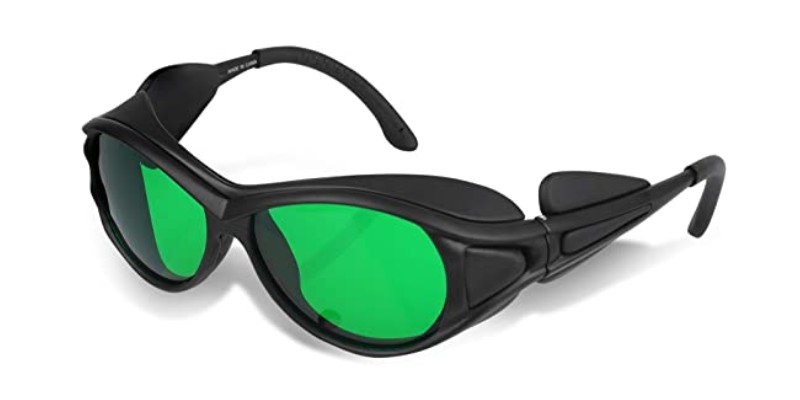
Pros
Easy to see while working.
Explosion-proof.
Cons
No major drawbacks.
Ortur is one of the biggest manufacturers of hobbyist laser engravers, such as its Laser Master range, but you can also use the Ortur laser safety glasses with other band machines.
A standout factor about these 445nm laser safety glasses is that they offer a much higher visible light transmittance than most others, with a very impressive 70%. This makes it easier to see while working, compared to other similar glasses.
These glasses are explosion-proof thanks to the high-quality polycarbonate lens, so you still get full protection even if the lens becomes scratched.
Jilerwear Professional
- Price: Check latest price at Amazon here
- Wavelengths: 190nm-1200nm
- Optical density: OD 6+
- Visible light transmission: 60%
- Laser safety standards: CN EN207
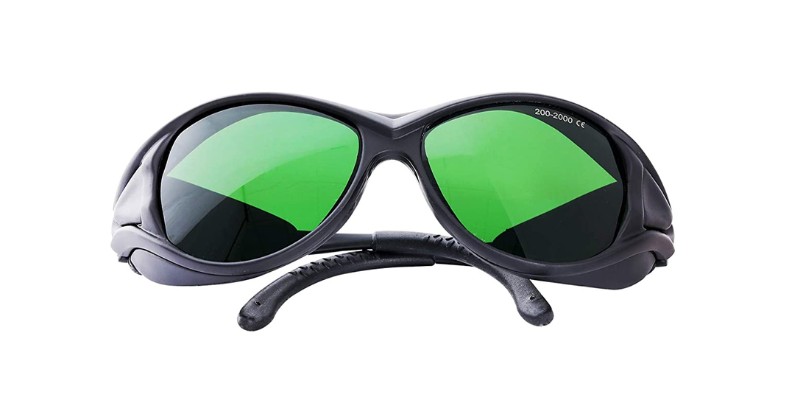
Pros
Versatile.
Wide range of wavelength coverage.
Can be used with a wide range of diode lasers.
Cons
A bit more expensive.
A more expensive but more versatile option are the Jilerwear professional laser safety glasses.
One of the main advantages they have for laser engraving over the likes of the FreeMascot ones is the wider wavelength coverage. You get the same protection from 190nm-490nm wavelengths, but these Jilerwear glasses also protect all the way up to 1200nm.
This means you can use a wider range of diode lasers, and they can also be used as fiber laser safety glasses if you’re using a low-wavelength fiber laser (fiber lasers generally range from 780 to 2200nm).
Another benefit is the 60% visible light transmission is higher than that of some other laser safety glasses, meaning you can see slightly clearer when wearing them, while still having a high OD rating.
These glasses are one of the most popular among users, with a 4.6 rating on Amazon from more than 430 reviews.
Best Laser Safety Glasses for CO2 Lasers
CO2 lasers are a more powerful option than diodes and also have significantly higher wavelengths, with 10,600nm typical of laser cutting machines.
FreeMascot 90% VLT
- Price: Check latest price at Amazon here
- Wavelengths: 9000nm-1100nm
- Optical density: OD 6+
- Visible light transmission: 95%
- Laser safety standards: CN EN207
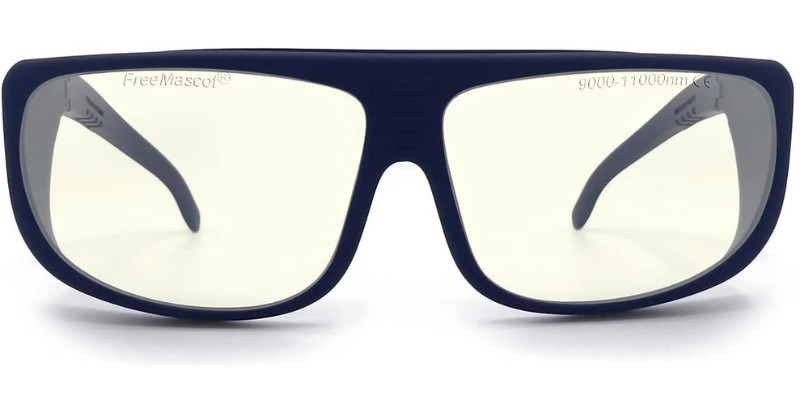
Pros
Unparalleled viewing quality.
Has perfect wavelength protection.
Good value for money.
Cons
No major drawbacks.
If you’re looking for the best CO2 laser safety goggles for visible light transmission, then you can’t look past the FreeMascot 90% VLT glasses, which provide an almost unparalleled viewing quality.
These 10600nm CO2 laser safety glasses have a strong OD rating thanks to the high-quality polycarbonate lens. While they have the perfect wavelength protection range for working with CO2 lasers, they’re not suitable for use with diodes and other lower wavelength glasses.
Overall, these are really good value and are probably the best CO2 laser eye protection glasses on the market.
Best Laser Cutter Safety Glasses for Infrared and Fiber Lasers
Most laser glasses used in infrared and fiber laser cutters and engravers use the same wavelength – 1060nm. This is the optimum wavelength for engraving reflective metals like gold and silver.
FreeMascot OD 8+
- Price: Check latest price at Amazon here
- Wavelengths: 190nm-450nm & 800nm-1100nm.
- Optical density: OD 8+
- Visible light transmission: 65%
- Laser safety standards: CN EN207
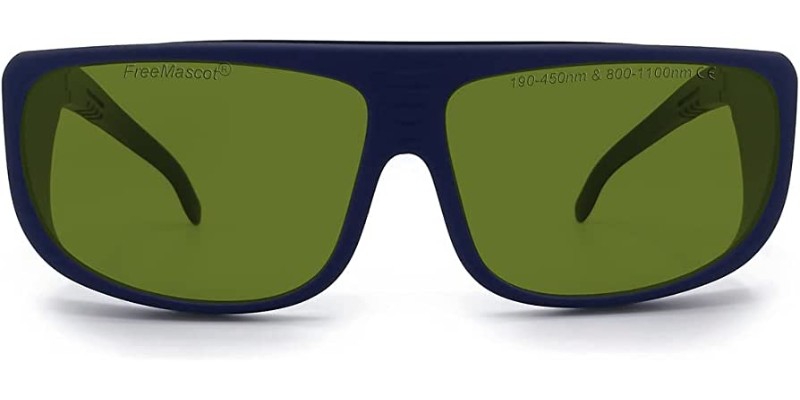
Pros
Suitable for working with most hobbyist laser cutters.
Fantastic protection.
Cons
Doesn’t cover as wider wavelength ranges as some other laser safety glasses.
As fiber and infrared lasers are more powerful than diodes, it’s important to ensure you have highly protective glasses. Some cheap glasses cover the relevant wavelengths, but have low ODs, meaning they’re unsuitable for working with more intense lasers.
This pair however, is suitable. Although the FreeMascot OD 8+ laser safety glasses don’t cover as wider wavelength ranges as some others, these polycarbonate glasses are still suitable for working with most hobbyist laser cutters and have one of the highest optical density ratings.
They offer this fantastic protection without compromising on your visibility, too, with a really impressive 65% VLT that allows you to see clearly while wearing the glasses.
MCWlaser Safety Glasses
- Price: Check latest price at Amazon here
- Wavelengths: 190nm-540nm & 800nm-1700nm.
- Optical density: OD 5+
- Visible light transmission: 35%
- Laser safety standards: CN EN207
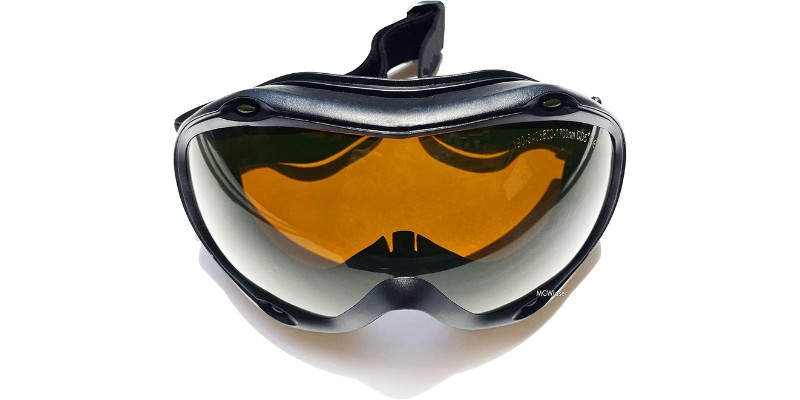
Pros
Has a wide field of view.
They block two wavelength ranges.
Made with hardened and strengthened optical material.
Cons
Expensive.
Many cheaper laser safety glasses are fairly small and aren’t suitable for wearing prescription glasses underneath. If you need to keep your prescription glasses on while using your laser, the MCWlaser safety goggles are a great choice.
These are much larger than the other glasses we’re reviewed and more resemble ski goggles, so they’re ideal for even prescription glasses of any size. Another benefit of having larger glasses is that you have a wider field of view than with smaller models.
They also block two wavelength ranges: 190nm to 540nm, and 800nm to 1700nm. This means you can use them as fiber optical laser safety glasses, and for infrared and diode lasers.
They’re well made, with hardened and strengthened optical material used in the anti-impact, anti-scratch, and explosion-proof lens.
On the other hand, they don’t have a great visible light transmission with just 35%, and they are pretty expensive. But if you’re after a larger and more comfortable pair for working with most laser types, they’re certainly worth considering.
Do Safety Glasses Protect From Lasers?
Yes, if you have the appropriate glasses. Lasers have different wavelengths, so you must ensure your glasses block the wavelength of the laser you’re using. If they do, you can laser engrave safely with your eyes protected – although you should still avoid looking directly at a laser source.
What kind of glasses do you need for laser engraving?
For laser engraving, you need safety glasses with an appropriate optical density (at least 4+) that filter the wavelength of the laser you’re using.
How to choose the right laser safety glasses for you
If you’re wondering how to choose laser safety glasses, here are the key factors to keep in mind:
Laser wavelength
The MOST important factor is ensuring your glasses block the wavelength of the laser you’re using. The four types of lasers used in engraving machines – diode, CO2, infrared, and fiber – can vary in terms of wavelength.
Diode lasers are typically under 500nm, while the infrared and fiber lasers used in cutters and engravers have a wavelength of 1064nm, although this can vary. Fiber lasers, for example, can have a wavelength of anywhere from 780nm-2200nm. CO2 lasers have much higher wavelengths, typically 10,600nm.
| Laser Type | Wavelength (nm) |
|---|---|
| Diode Lasers | < 500 |
| Infrared and Fiber Lasers | 1064 (can vary between 780-2200) |
| CO2 Lasers | 10,600 (but can be 9.3 µm, 10.2 µm, and 10.6 µm) |
Laser safety glasses only block certain wavelengths; 1064nm laser safety glasses may not be suitable for use with a diode laser, for example.
Similarly, as K40 engravers use CO2 lasers, you wouldn’t want to use low wavelength goggles as K40 laser safety glasses. So, make sure you know the wavelength of your laser so you can pick the safest glasses.
Optical density
Optical density (OD) measures the attenuation of a laser as it passes through a medium. In layman’s terms, this means how much of a laser is able to pass through a filter medium like a glass lens.
For example, if 100% of a laser passes through the filter, the attenuation factor is 1 and the OD is 0. When buying laser safety glasses for laser cutting, you should make sure the OD is at least 4+, although if you’re doing a lot of regular and intensive laser work, 6+ is recommended – this equates to just 0.0001% transmission.
Laser safety standards (they differ around the world)
The only way to truly make sure that your UV laser safety glasses will do the job is to check that they’re regulated and certified to the laser safety standard of the region you’re in.
Most countries outside the US and EU have their own standards, although they’re often derived from these two standards.
If you’re in the US, you need to make sure the glasses are regulated as per the ANSI Z136 standard, while in Europe the standards are EN207, EN208, and EN60825. This means the glasses have been tested to ensure they’re safe to use.
Visible light transmission
Visible light transmission is the amount of visible light that passes through a medium, in this case, a lens. Expressed as a percentage, the lower the visible light transmission, the darker the lens and the harder it is to see clearly through the glasses.
The visible light transmission of glasses that protect from lasers typically varies all the way from 30% up to 30%. So, the differences can be large, and even 5% can have a significant impact on the clarity of your vision when wearing glasses. So it’s important to consider, particularly as you need a clear view to monitor your laser engraver while it’s in operation.
Comfort & size
If you’re doing lots of laser engraving, it’s important to ensure you have a safe and comfortable pair of glasses. Different models have slightly different frames, shapes, and designs, which can impact comfort.
The best way to gauge a laser’s comfortability is by reading user reviews – such as on Amazon. Each pair of glasses’ overall rating is broken down by subcategories, one of which is comfort.
It’s also important to consider the size of diode, fiber, infrared, and CO2 laser safety glasses, particularly if you wear prescription glasses and need to fit the goggles over the top. The MCW laser safety glasses are a good choice for this.
Price
The above factors impact the price of blue laser safety glasses. For example, glasses with wider wavelengths and higher visible light transmissions can sometimes cost double the price of glasses with narrow wavelengths and lower VLT.
So, knowing what protection you need and considering other factors can help you find the right pair for your budget.
FAQs
Do you need laser safety glasses?
Yes, if you’re using a laser engraver or doing anything else that involves a laser, you should definitely wear safety glasses to protect your eyes. Looking directly at an active laser without any protection or a laser enclosure can negatively affect your eyesight, and be dangerous.
Are all laser safety glasses the same?
No, different laser safety glasses are made of different materials that block different wavelengths, so it’s vital to get an appropriate pair for the laser you’re using. Diode, CO2 and fiber lasers all have different wavelengths, and require different laser safety glasses to protect your vision.
Can you look directly at your laser beam when wearing laser safety glasses?
No, you should avoid looking directly at a laser beam, even when wearing safety glasses, to help reduce any risk to your eyesight. You can further improve safety by using an enclosure around your laser to prevent accidentally looking at the laser beam while it’s working.











